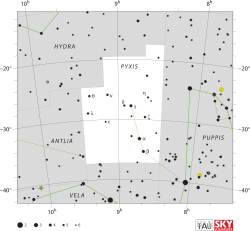
Summary
Delta Pyxidis (δ Pyxidis) is binary star[9] system in southern constellation of Pyxis. Having an apparent visual magnitude of +4.877,[2] it is bright enough to be visible to the naked eye. Based upon an annual parallax shift of 13.19 mas as seen from Earth,[1] it is located around 250 light years from the Sun.
| Observation data Epoch J2000.0 Equinox J2000.0 (ICRS) | |
|---|---|
| Constellation | Pyxis |
| Right ascension | 08h 55m 31.56948s[1] |
| Declination | −27° 40′ 54.7315″[1] |
| Apparent magnitude (V) | +4.877[2] |
| Characteristics | |
| Spectral type | A3 IV[3] |
| U−B color index | +0.224[2] |
| B−V color index | +0.130[2] |
| Astrometry | |
| Radial velocity (Rv) | 5.4±0.8[4] km/s |
| Proper motion (μ) | RA: +81.90[1] mas/yr Dec.: −100.43[1] mas/yr |
| Parallax (π) | 13.19 ± 0.77 mas[1] |
| Distance | 250 ± 10 ly (76 ± 4 pc) |
| Absolute magnitude (MV) | +0.67[5] |
| Details | |
| Mass | 1.84[6] M☉ |
| Radius | 1.6[7] R☉ |
| Luminosity | 59[3] L☉ |
| Surface gravity (log g) | 3.77±0.14[6] cgs |
| Temperature | 8,609±293[6] K |
| Rotational velocity (v sin i) | 68[6] km/s |
| Age | 296[6] Myr |
| Other designations | |
| Database references | |
| SIMBAD | data |
In Chinese, 天狗 (Tiān Gǒu), meaning Celestial Dog, refers to an asterism consisting of δ Pyxidis, e Velorum, f Velorum, β Pyxidis, α Pyxidis and γ Pyxidis. Consequently, δ Pyxidis itself is known as 天狗七 (Tiān Gǒu qī, English: the Seventh Star of Celestial Dog.)[10]
This is an astrometric binary system, as determined by changes in the proper motion of the primary.[11] The visible component has a stellar classification of A3 IV,[3] indicating it has the spectrum of an A-type subgiant star that is consuming the last of the hydrogen at its core. At the age of around 296 million years,[6] it is 92.5%[3] of the way through its main sequence lifetime and is spinning with a projected rotational velocity of 68 km/s.[6] The star has an estimated 1.8[6] times the mass of the Sun and about 1.6[7] times the Sun's radius. It is radiating 59[3] times the Sun's luminosity from its photosphere at an effective temperature of roughly 8,609 K.[6]
References edit
- ^ a b c d e f van Leeuwen, F. (2007), "Validation of the new Hipparcos reduction", Astronomy and Astrophysics, 474 (2): 653–664, arXiv:0708.1752, Bibcode:2007A&A...474..653V, doi:10.1051/0004-6361:20078357, S2CID 18759600.
- ^ a b c d Gutierrez-Moreno, Adelina; et al. (1966), "A System of photometric standards", Publications of the Department of Astronomy University of Chile, 1, Publicaciones Universidad de Chile, Department de Astronomy: 1–17, Bibcode:1966PDAUC...1....1G.
- ^ a b c d e Zorec, J.; Royer, F. (January 2012), "Rotational velocities of A-type stars. IV. Evolution of rotational velocities", Astronomy & Astrophysics, 537: A120, arXiv:1201.2052, Bibcode:2012A&A...537A.120Z, doi:10.1051/0004-6361/201117691, S2CID 55586789.
- ^ de Bruijne, J. H. J.; Eilers, A.-C. (October 2012), "Radial velocities for the HIPPARCOS-Gaia Hundred-Thousand-Proper-Motion project", Astronomy & Astrophysics, 546: 14, arXiv:1208.3048, Bibcode:2012A&A...546A..61D, doi:10.1051/0004-6361/201219219, S2CID 59451347, A61.
- ^ Anderson, E.; Francis, Ch. (2012), "XHIP: An extended hipparcos compilation", Astronomy Letters, 38 (5): 331, arXiv:1108.4971, Bibcode:2012AstL...38..331A, doi:10.1134/S1063773712050015, S2CID 119257644.
- ^ a b c d e f g h i David, Trevor J.; Hillenbrand, Lynne A. (2015), "The Ages of Early-Type Stars: Strömgren Photometric Methods Calibrated, Validated, Tested, and Applied to Hosts and Prospective Hosts of Directly Imaged Exoplanets", The Astrophysical Journal, 804 (2): 146, arXiv:1501.03154, Bibcode:2015ApJ...804..146D, doi:10.1088/0004-637X/804/2/146, S2CID 33401607.
- ^ a b Pasinetti Fracassini, L. E.; Pastori, L.; Covino, S.; Pozzi, A. (February 2001), "Catalogue of Apparent Diameters and Absolute Radii of Stars (CADARS)", Astronomy and Astrophysics, 367 (3rd ed.): 521–524, arXiv:astro-ph/0012289, Bibcode:2001A&A...367..521P, doi:10.1051/0004-6361:20000451, S2CID 425754.
- ^ "del Pyx". SIMBAD. Centre de données astronomiques de Strasbourg. Retrieved 2017-07-19.
{{cite web}}: CS1 maint: postscript (link) - ^ Eggleton, P. P.; Tokovinin, A. A. (September 2008), "A catalogue of multiplicity among bright stellar systems", Monthly Notices of the Royal Astronomical Society, 389 (2): 869–879, arXiv:0806.2878, Bibcode:2008MNRAS.389..869E, doi:10.1111/j.1365-2966.2008.13596.x, S2CID 14878976.
- ^ (in Chinese) AEEA (Activities of Exhibition and Education in Astronomy) 天文教育資訊網 2006 年 7 月 17 日
- ^ Frankowski, A.; et al. (March 2007), "Proper-motion binaries in the Hipparcos catalogue. Comparison with radial velocity data", Astronomy and Astrophysics, 464 (1): 377–392, arXiv:astro-ph/0612449, Bibcode:2007A&A...464..377F, doi:10.1051/0004-6361:20065526, S2CID 14010423.



